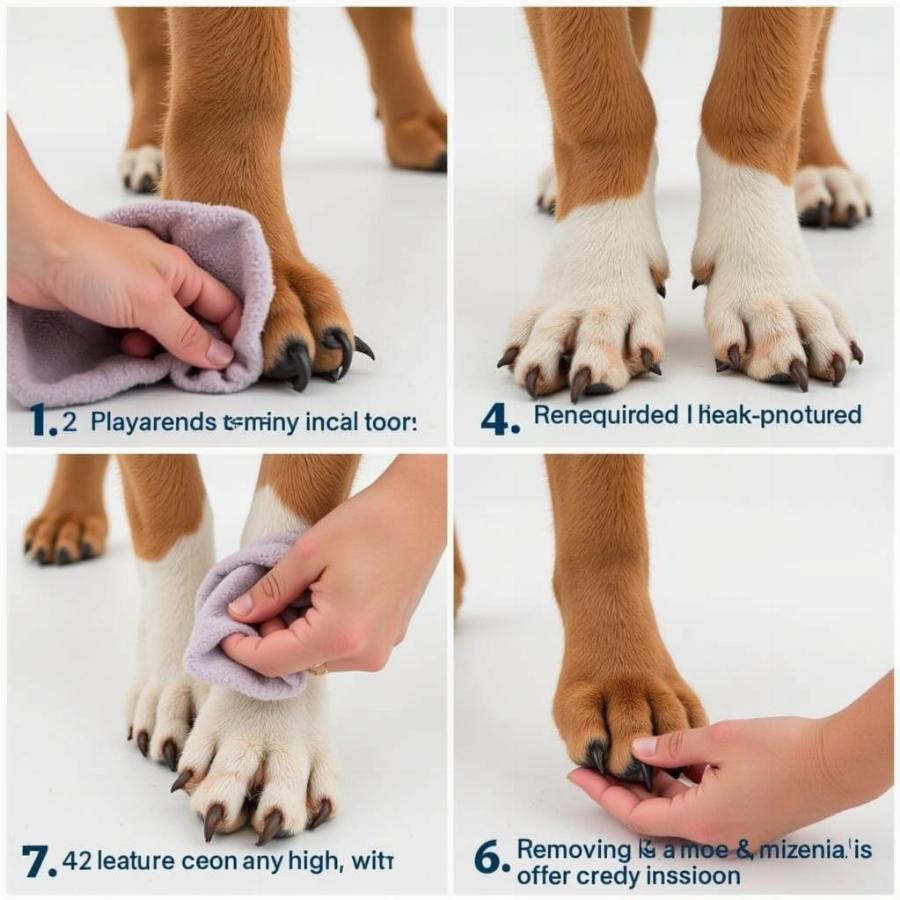Dog paw medicine encompasses a wide range of care practices and treatments aimed at keeping your furry friend’s paws healthy and happy. From everyday maintenance to addressing specific ailments, understanding dog paw medicine is crucial for responsible dog ownership. This guide will delve into the essential aspects of paw care, equipping you with the knowledge to protect your dog’s paws and address any potential issues.
Understanding Common Paw Problems
Just like our feet, a dog’s paws are susceptible to various problems. Knowing the common issues can help you identify and address them promptly. Some frequent paw problems include cuts, abrasions, burns (from hot pavement), dryness, cracking, infections, allergies, and parasites like ticks. Recognizing the symptoms, such as limping, excessive licking, redness, swelling, or discharge, is the first step towards providing appropriate care.
Cuts and Abrasions: First Aid and Prevention
Cuts and abrasions are common, especially for adventurous dogs. Clean the wound with mild antiseptic solution and apply a pet-safe bandage. For deeper cuts, consult a veterinarian. Preventative measures include trimming nails regularly and checking paws after walks for debris.
Dry and Cracked Paws: Moisturizing and Protection
Dry and cracked paws can be uncomfortable for your dog. Use a paw balm or moisturizer specifically designed for dogs to hydrate and soothe the skin. In winter, consider using booties to protect paws from harsh weather conditions like ice, snow, and de-icing chemicals.
Paw Infections: Recognizing and Treating
Paw infections can be caused by bacteria, fungi, or yeast. Symptoms include redness, swelling, discharge, and a foul odor. Veterinary intervention is crucial for diagnosis and treatment, which may involve antibiotics, antifungals, or other medications.
Choosing the Right Dog Paw Medicine
Choosing the right dog paw medicine depends on the specific condition affecting your dog’s paws. For minor cuts and abrasions, antiseptic solutions and bandages are sufficient. Dry and cracked paws benefit from moisturizing balms. However, for infections, allergies, or parasitic infestations, consulting a veterinarian is essential for accurate diagnosis and appropriate medication. Never self-treat serious paw problems, as this can worsen the condition.
What to Look for in Dog Paw Products
When selecting paw care products, opt for those specifically formulated for dogs. Avoid human products, as they may contain ingredients harmful to pets. Look for natural ingredients and avoid fragrances or dyes that can irritate sensitive skin.
Preventing Paw Problems
Prevention is always better than cure. Regular paw checks, nail trims, and paw cleaning can prevent many common problems. Protecting paws from extreme weather conditions with booties and avoiding walking on hot pavement during summer months are also essential preventative measures.
Keeping Your Dog’s Paws Clean
Regularly cleaning your dog’s paws, especially after walks, can remove dirt, debris, and potential irritants. Use a damp cloth or paw wipes to clean the paws and between the toes.
 Cleaning Dog Paws After a Walk: Removing Dirt and Debris
Cleaning Dog Paws After a Walk: Removing Dirt and Debris
When to See a Vet
If your dog is exhibiting signs of pain, limping, excessive licking, or any unusual changes in their paws, it’s crucial to seek veterinary attention. Early diagnosis and treatment can prevent minor issues from escalating into more serious problems.
Conclusion
Dog paw medicine involves a combination of preventative care and targeted treatments to ensure your dog’s paw health. By understanding common paw problems, choosing appropriate products, and practicing regular paw maintenance, you can help your furry friend enjoy a happy and active life, free from paw discomfort. Remember, healthy paws are essential for a happy dog!
FAQ
-
How often should I clean my dog’s paws? Ideally, clean your dog’s paws after every walk, especially if they’ve been in muddy or dirty areas.
-
Can I use human moisturizer on my dog’s paws? No, it’s best to use paw balms specifically formulated for dogs, as human products may contain harmful ingredients.
-
Why is my dog licking their paws excessively? Excessive licking can be a sign of various issues, including allergies, infections, parasites, or injuries. Consult a vet for diagnosis.
-
What are the signs of a paw infection? Redness, swelling, discharge, a foul odor, and limping are common signs of a paw infection.
-
How can I protect my dog’s paws in winter? Use booties to protect paws from snow, ice, and de-icing chemicals.
-
What can I do for dry and cracked dog paws? Apply a dog-specific paw balm or moisturizer regularly.
-
When should I take my dog to the vet for paw problems? If your dog is limping, licking excessively, or showing any signs of discomfort or infection, consult a veterinarian.
Beaut Dogs: Your Comprehensive Resource for Dog Care
Beaut Dogs (https://beautdogs.com) is your one-stop destination for all things related to dog care, providing expert advice and valuable resources to help you keep your canine companion healthy and happy. From breed information to paw care and everything in between, we’re here to support you on your journey as a dog owner. When you need assistance, don’t hesitate to contact us at [email protected] (Email address) for detailed and accurate answers to your questions.